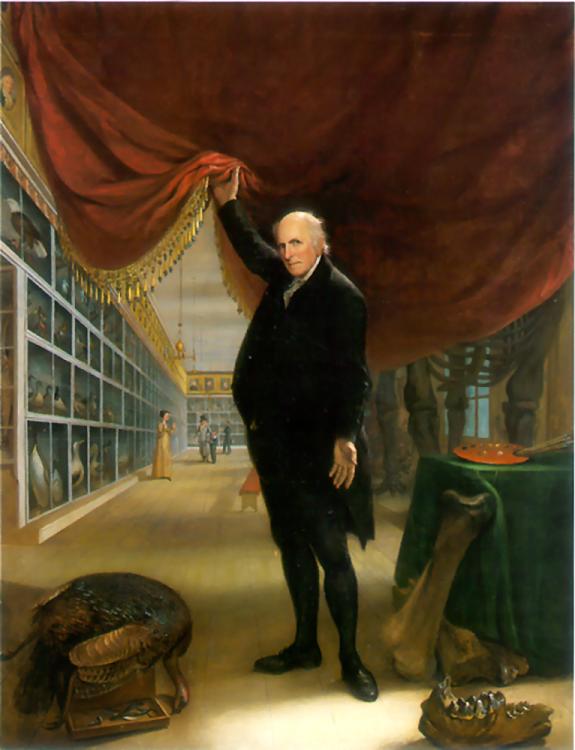Photo courtesy of wikipedia
Charles Wilson Peale: ever heard of him?
Most people haven’t heard his name, but they probably have seen his work. Peale was one of the most famous portrait artists in the Colonies, and later the new United States, in the late 18th Century. He painted seven portraits of George Washington, some of Benjamin Franklin, Thomas Jefferson, John Hancock and many other founding fathers. He is known as the “Painter of the American Revolution“.
After the American Revolution, Peale continued to paint and exhibit his works but in his later years he became increasingly interested in science. In the mid-1780s he set up one of the first natural history museums in the United States on the second floor of Independence Hall to exhibit his growing collection of gadgets, paintings and preserved animals. This is where the Mastodon comes in. Fossils of these animals, usually small, fragmentary pieces, had been popping up for decades in the New England colonies. At first these remains were a complete mystery, but as more samples came to light scholars began to realize that the bones were quite similar to those of elephants, but with important differences. It was during this period that the concept of extinction first came to light, and Mastodons were one of the most obvious examples of life forms that no longer existed.
In 1799, John Marsten discovered large animal bones on his farm outside Newburgh, New York. When they were identified as “mammoth” bones (people did not understand the difference between mastodons and mammoths at the time), Peale purchased them and paid Marsten for permission to search his property for more. Some of the bones discovered during this early paleontology excavation were submerged in a pond; the ensuing recovery effort is chronicled in the amazing painting below.
Photo Courtesy of extinct monsters.net
Peale and his son Rembrandt, Marsten, and many others were involved in the excavation of the fossils which were later exhibited in Peales’ museum. Although Peale wrongly believed that the animal was a vicious carnivore, his exhibit did a lot to expand public knowledge and interest in the subject of paleontology and was a source of great national pride.
Part of the reason the skeleton was such a big deal was because scholars in Europe at the time did not have a very high opinion of American fauna. They thought that the Americas had a volatile climate, poor soil, and limited sources of nutrition and that this deficit in natural abundance meant that native animal life forms—including people—were mentally and physically inferior to their European counterparts.
One of the proponents of this theory was Georges-Louis Leclerc Cout de Buffon, a famous French naturalist who not only proposed that the earth and other planets in the solar system were created by celestial collisions, but who also supported an early theory of speciation that vaguely suggested evolution. Buffon proposed that the earth was around 70,00 years old and that life had formed in a hot, primordial world in which the earth was still cooling from its fiery birth. His theory continued to say that animals were created spontaneously during this time, and then over the ages many of the larger animals migrated to the equator. This was the basis for his explanation of why Mammoth bones were found in Russia and Mastodon bones found in North America. He asserted that as these animals migrated, they changed a little to become better suited to their new environment: in essence, they adapted.
This idea, although not appreciated by many scholars at the time, was a great leap forward in the understanding of life on earth. Unfortunately, some of the assertions he made in his writings were not so great for science, or politics for that matter. For example, Buffon proposed that it was adaption to the poor climate of the Americas that lead to the mental and physical “inferiority” of native humans and animals. This idea, held by many scholars of the time including Buffon, would affect society in the Americas for the next two hundred years. As late as the 1940’s, Latin American governments created programs to encourage indigenous and mestizo citizens to eat European products to improve their physical and mental capacity, a sort of neo-Eugenics.
This theory was heavily disliked by early scholars and statesmen in the Unites States, partly because they were proud of their country and didn’t want it to be considered “lacking” in anything, and partly because the theory suggested that they too suffered the loss of nutrition and good climate and therefore could not live up to their European brethren. The “mammoths” were considered by Thomas Jefferson the be the “living” proof that the European scholars were wrong, and he even urged Lewis and Clarke to keep an eye out for living specimens during their journey. The Mastadon on display in Peale’s museum became a symbol of national pride and of the living diversity of North America’s wilderness, something the the U.S. is still famous for today.
So there you have it, from artist to paleontologist, Charles Willson Peale helped shape international perception of the Unites States. Although many people today have never heard of him, he lives on in the international legend of the heroic formation of the United States and the perception of the U.S. as the “land of plenty”. If you want to learn more about Peale, and the other men and women who have worked for the last 200 years to form a more perfect union, check out out new special exhibition Amending America: The Bill of Rights.









